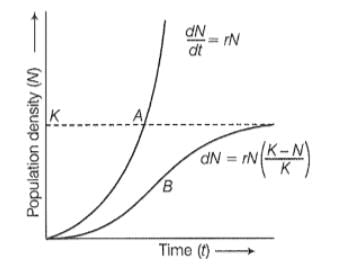Test: Population: Attributes & Growth - NEET MCQ
15 Questions MCQ Test - Test: Population: Attributes & Growth
Which of the following would necessarily decrease the density of a population in a given habitat?
The rate of individuals born per 1,000 individuals per year is called
The formula for exponential population growth is
Growth of the population of an area depends on
When the number of immigration and births is more than emigration and deaths, the growth curve of the population will show
Population growth curve is sigmoid if the growth pattern is
Match the items in Column A with the correct descriptions in Column B.

If in a population, natality is balanced by mortality, then there will be
The graph shows two types of population growth curve. A is exponential and B is logistic.

Which one of the following growth model considered as more realistic one?
Which of the following equations represents logistic population growth?
Which of the following statements best describes the relationship between natality, mortality, immigration, and emigration in a population?
1. Natality and immigration both contribute to an increase in population size.
2. Mortality and emigration both contribute to an increase in population size.
3. Natality is the number of births per capita, while mortality refers to the number of deaths in a population during a given time period.
4. Immigration decreases the population density by bringing in individuals from outside the habitat.
Consider the following statements about population growth and dynamics:
1. Exponential growth occurs only when resources are limited.
2. Logistic growth models show a sigmoid curve and account for carrying capacity.
3. Natality, mortality, immigration, and emigration are the four main factors that influence population size.
4. The intrinsic rate of natural increase (r) is constant and unaffected by environmental conditions.
Which of the following options is correct?
Which of the following statements are correct?
(i) Organisms with high reproductive rates (r value) evolve to maximize their reproductive fitness.
(ii) Organisms that breed only once in their lifetime are more likely to have large offspring.
(iii) The evolution of life history traits is unaffected by the constraints of the habitat.
(iv) Different species evolve life history traits based on both biotic and abiotic factors of their environment.



















